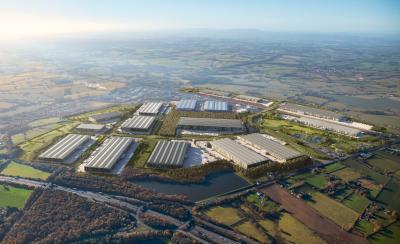Work has begun on the £1 billion West Midlands Interchange (WMI) project in South Staffordshire, which could create up to 8,500 jobs. The site is on land west of junction 12 of the M6.
During the construction phase, employment, apprenticeship and trainee positions will be created. A partnership of Staffordshire County Council, City of Wolverhampton Council and South Staffordshire Council is already working with West Midlands Interchange to maximise the site’s future potential to their residents.
The recently created Staffordshire Jobs and Careers Service will support WMI in its search for candidates to fill new roles, whilst Wolves at Work will do the same in the city. Both will also help those looking for employment, apprenticeships or training to match them with appropriate positions at WMI.
People can find out more at Staffordshire Jobs and Careers or Workbox.
The development is being carried out by Winvic Construction. Winvic joins Oxford Properties and Logistics Capital Partners in the delivery team for the construction of this strategic site. The site is being financed and delivered by Oxford Properties, in partnership with European developer Logistics Capital Partners.
When it is operational, the 734 acre site at Four Ashes will have a freight terminal with direct connections to the West Coast mainline. It will be capable of accommodating up to 10 trains per day as well as container storage and HGVs.
Up to 8 million square feet of commercial space will be built on the site and 109 acres has also been assigned for 2 community parks.
Phase 1 work includes the construction of warehouses, developing one of the community parks with walkways, cycle paths and building part of a new road.
City of Wolverhampton Council cabinet member for jobs and skills Louise Miles said: “It is vital that we help Wolverhampton residents connect to the thousands of jobs and training opportunities that will be on offer just across the city border at the West Midlands Interchange.
“As the project progresses, our successful Wolves at Work team is available to support people interested in roles either during the construction phase or with the businesses that locate there.
“Working in partnership with Staffordshire County Council and South Staffordshire Council we will build strong relationships with WMI employers and develop a recruitment process that benefits all our citizens.”
Staffordshire County Council’s deputy leader and cabinet member for economy and skills Philip White said: “The West Midlands Interchange is a huge development that will generate numerous and varied opportunities for our residents in years to come.
“With our partners we have been on the front foot in establishing a relationship with WMI from the outset to maximise its potential locally.
“It will be a key logistics hub in the region and nationally, operating on an extensive scale which is why approval was made at Government level rather than by local authorities. Ultimately this is about taking freight off our roads and onto the rail network.
“We know there has been apprehension locally, but we must now focus on the benefits of the development in terms of employment and training, whilst mitigating environmental and traffic impact and ensuring that commitments to environmental and community enhancements are realised.”
Deputy leader for South Staffordshire Council and cabinet member for business and enterprise, Victoria Wilson, said: “We at South Staffordshire are committed to working collectively to ensure that the benefits of this scheme are felt locally by the residents and communities of South Staffordshire and we urge job seekers to look at the roles that are available and engage with the opportunities that the scheme offers.”
Plans for the Interchange were first revealed 7 years ago and the project received the green light from the Secretary of State for Transport in 2020. It is anticipated that the development will take a decade to complete.
